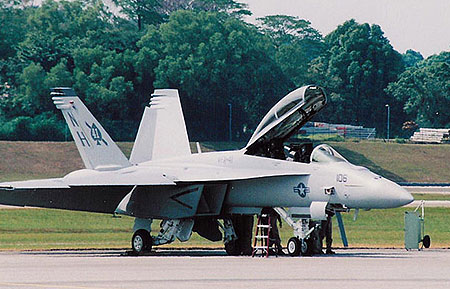 Asian
Aerospace 2002
Asian
Aerospace 2002
Changi International Exhibition and Convention Centre, Singapore 26 February - 3 March
Edwin Lim reports on the Far East's aviation showpiece.
Asian Aerospace 2002 heralded a change in the aviation industry from its indeterminable slide in 2001, particularly following the September terrorist attacks in the United States. Despite the searing sun and stifling humidity, a feature not uncommon with Singapore, crowds numbering about 60,000 visited the show from its opening on Tuesday 25 February 2002 to the final day on Sunday 3 March.
Held at the Changi International Exhibition and Convention Centre, 900 exhibitors from 27 countries around the world displayed their latest products and services to both trade and public visitors. Security was tight and akin to entering an airport departure area. Every visitor was subjected to a metal detector scan and all bags were sent through an x-ray machine, a particularly exhausting process for those left waiting in the long queues that formed on opening day.
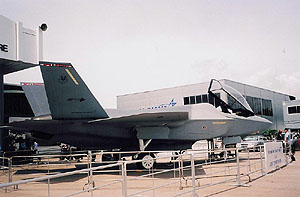 The
intense competition between aviation giants Lockheed Martin and European
consortium Eurofighter GmbH was evident during the show from the very
beginning. Mock-ups of the rival companies' latest aircraft greeted visitors
as soon as they stepped past the security screening. The large full-scale
replicas of Lockheed Martin's Joint Strike Fighter and Eurofighter GmbH's
latest Eurofighter Typhoon strongly reflected both companies' interests
in wooing operators from the Asian region and were on display at the show
for the first time.
The
intense competition between aviation giants Lockheed Martin and European
consortium Eurofighter GmbH was evident during the show from the very
beginning. Mock-ups of the rival companies' latest aircraft greeted visitors
as soon as they stepped past the security screening. The large full-scale
replicas of Lockheed Martin's Joint Strike Fighter and Eurofighter GmbH's
latest Eurofighter Typhoon strongly reflected both companies' interests
in wooing operators from the Asian region and were on display at the show
for the first time.
Lockheed Martin's JSF had in October 2001 won the US government's bid to produce a next-generation fighter in a US$200 billion competition against Boeing and decided to showcase its winner prominently at the show. Officially designated as the F-35, the JSF is a multi-role jet fighter incorporating stealth technology available in three variants: Conventional takeoff and landing (CTOL), short takeoff and vertical landing (STOVL) and the carrier variant (CV).
Designed
to replace the current generation of fighter/ attack aircraft like the
F-16, Harrier and A-10, one of the JSF's unique features is its shaft-driven
lift fan propulsion system that produces the aircraft's vertical lift.
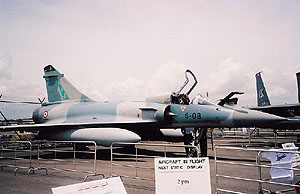 Developed
for a variety of military applications, the JSF's vertical flight capability
is only limited to landing and would hence be an ideal replacement for
the US Marine Corps and UK Navy Harrier jets. Now
in its Systems Development and Demonstration (SDD) phase, the JSF project
has already incorporated the UK and Canada as working partners with intentions
to draw in the Netherlands, Italy, Denmark, Norway and Turkey as potential
partners in future. Powered
by Pratt & Whitney F119-661 engines and a Rolls Royce shaft-driven
lift fan, the JSF's angular features and futuristic cockpit had the crowds
swarming to take a peek into them. Lockheed
Martin expects international sales of the JSF to number between 2 - 3,000
aircraft when the development program is complete, and the first JSF will
be delivered to US operational units by 2008 with UK deliveries completed
by 2010.
Developed
for a variety of military applications, the JSF's vertical flight capability
is only limited to landing and would hence be an ideal replacement for
the US Marine Corps and UK Navy Harrier jets. Now
in its Systems Development and Demonstration (SDD) phase, the JSF project
has already incorporated the UK and Canada as working partners with intentions
to draw in the Netherlands, Italy, Denmark, Norway and Turkey as potential
partners in future. Powered
by Pratt & Whitney F119-661 engines and a Rolls Royce shaft-driven
lift fan, the JSF's angular features and futuristic cockpit had the crowds
swarming to take a peek into them. Lockheed
Martin expects international sales of the JSF to number between 2 - 3,000
aircraft when the development program is complete, and the first JSF will
be delivered to US operational units by 2008 with UK deliveries completed
by 2010.
With the introduction of the JSF, many countries now operating Lockheed Martin's F-16s face a difficult decision on whether to upgrade their F-16s to the E/F Block 60 variant or procure the JSF. While the JSF is meant as a replacement for the generation of aircraft the F-16 falls under, Lockheed Martin has provided air forces around the world with an option of maintaining their existing fleets with upgrades (the Block 60) or taking on the new generation aircraft. The Block 60s have an avionics suite upgrade, integrated forward looking infra-red (FLIR) targeting systems, advanced colour cockpit with larger multi-function displays (MFD) and enhanced engine performance, the new engine capable of producing 32,500 pounds of thrust. The most obvious difference on the Block 60 would be its unusual looking conformal fuel tanks (CFTs) that, holding 3,000 extra pounds of fuel, enable the aircraft's mission range to be extended to 800 nautical miles. Lockheed Martin has designed the aerodynamically shaped tanks to sit on the aircraft's fuselage just aft of the cockpit. An Okinawa-stationed USAF F-16C on static display at the show allowed visitors a life-sized visual comprehension of the Block 60's CFTs albeit a fibreglass one.
BAE Systems
also put up a strong presence at the show, showcasing not only its Hawk
100 Lead-In Fighter Trainer (LIFT) but also pushing the Eurofighter Typhoon
as part of its role in the 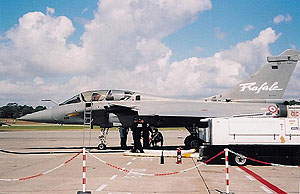 Eurofighter
GmbH consortium. The Eurofighter Typhoon at the show invited hordes of
visitors, the mock up sitting amidst its dummy armaments. Appearing in
competition with the JSF, the Eurofighter is now into its production phase.
Tasked as a strike, air combat and reconnaissance aircraft, 620 Eurofighter
Typhoons have been placed on firm order for the four consortium member
nations of Germany, Italy, Spain and UK. The countries will receive 180,
121, 87 and 232 aircraft respectively.
Eurofighter
GmbH consortium. The Eurofighter Typhoon at the show invited hordes of
visitors, the mock up sitting amidst its dummy armaments. Appearing in
competition with the JSF, the Eurofighter is now into its production phase.
Tasked as a strike, air combat and reconnaissance aircraft, 620 Eurofighter
Typhoons have been placed on firm order for the four consortium member
nations of Germany, Italy, Spain and UK. The countries will receive 180,
121, 87 and 232 aircraft respectively.
The aircraft, to be assembled in the countries of the consortium, was, to quote a Eurofighter test pilot at the show, designed from the cockpit outwards. The result is an impressive cockpit that incorporates a full suite of advanced avionics. These include the Hands-On Throttle and Stick (HOTAS) concept, through the 24 fingertip functions allowing the pilot to carry out complex tasks with ease and Direct Voice Input (DVI), which allows the pilot to control many aspects of the cockpit displays through aural commands thus allowing him to remain "head-out" for longer. The cockpit layout and design was based on a series of assessments conducted by operational pilots from the customer countries and unprecedented attention has been given to Man-Machine Interfaces (MMI) as reflected by the use of DVI and HOTAS. The Eurofighter has received export interest from Greece, the Netherlands, Korea, Australia, Saudi Arabia and Singapore. Korea is now assessing the Eurofighter as part of its FX aircraft replacement program. Greece has already signed a contract to procure 60 Eurofighter Typhoons with a further 30 on option. Owing to the Greek government's alteration of its defence budget allocations since the country was chosen as the site for the 2004 Olympics, negotiations are ongoing to determine the delivery date of the aircraft. This will be finalised by 2004 or 2005.
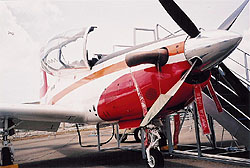 Asian
Aerospace 2002 also exhibited the growing strength of Asian aviation companies
and their emergence into the international aerospace market. Korea Aerospace
Industries (KAI) chose to present their KT-1 advanced jet trainer to the
show for the first time, intended as replacements for the Republic of
Korea Air Force's (ROKAF) T-37 and T-41 trainers. Confident
of developing an export market in the region, KAI flew in two of their
Pratt and Whitney PT-6A-62 powered turboprops to Changi, putting the versatile
aircraft through its paces during the daily aerial display. The aircraft
is capable of aerobatic manoeuvres and its design profile allows the aircraft
to achieve low stall speeds and make excellent spin recovery. Boasting
an advanced avionics suite, the KT-1 is mission capable and its flexibility
in being able to be configured for forward air controller roles as well
as an advanced jet trainer may see regional Asian air forces looking towards
it. 35 of the aircraft are already in operation with ROKAF.
Asian
Aerospace 2002 also exhibited the growing strength of Asian aviation companies
and their emergence into the international aerospace market. Korea Aerospace
Industries (KAI) chose to present their KT-1 advanced jet trainer to the
show for the first time, intended as replacements for the Republic of
Korea Air Force's (ROKAF) T-37 and T-41 trainers. Confident
of developing an export market in the region, KAI flew in two of their
Pratt and Whitney PT-6A-62 powered turboprops to Changi, putting the versatile
aircraft through its paces during the daily aerial display. The aircraft
is capable of aerobatic manoeuvres and its design profile allows the aircraft
to achieve low stall speeds and make excellent spin recovery. Boasting
an advanced avionics suite, the KT-1 is mission capable and its flexibility
in being able to be configured for forward air controller roles as well
as an advanced jet trainer may see regional Asian air forces looking towards
it. 35 of the aircraft are already in operation with ROKAF.
Choosing AA 2002 as an ample opportunity to showcase their wares to the region, other military aircraft that debuted at the show include the Boeing F-15E Strike Eagle and F/A-18F Super Hornet whose most obvious difference from its previous variants, is its rectangular intakes; Alenia Aerospazio C-27J military transport (developed in conjunction with Lockheed Martin) and BAE Systems Hawk 100 trainer.
On the commercial aviation side of the show, the following aircraft made their debut: CATIC/Xian Aerospace MA 60 transport aircraft, Layang Layang Aerospace An-38-100 transport aircraft, Pilatus PC-12, Bombardier Global Express business jet, Cessna Citation Excel and Australia's only commercial aircraft manufacturer, Gippsland Aeronautics' GA8 Skyvan.
General aviation aircraft like the Letecke Zavody/LG Zlin Z143 and Cessna's C172 Turbo Skylane also made their first appearances at the show, not forgetting the agile Eurocopter EC 120B as witnessed during its enthusiastically aerobatic daily aerial display and its colourfully painted partner, the EC 130.
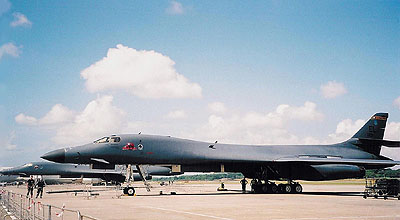 The
airshow's static display also proved to be a huge drawcard for many visitors,
showcasing both new aircraft to the show as well as perennial favourites
like the F-16, F-15, Rafale and Mirage 2000. Parked
on the West Cargo Apron a shuttle-bus ride away, sat the heavies - two
USAF B-1B Lancers, a USAF KC-135 refuelling tanker,
US Navy P-3 Orion and an Omega Air Tanker B707.
The
airshow's static display also proved to be a huge drawcard for many visitors,
showcasing both new aircraft to the show as well as perennial favourites
like the F-16, F-15, Rafale and Mirage 2000. Parked
on the West Cargo Apron a shuttle-bus ride away, sat the heavies - two
USAF B-1B Lancers, a USAF KC-135 refuelling tanker,
US Navy P-3 Orion and an Omega Air Tanker B707.
The B-1Bs made an impressive aerial display, demonstrating its agility and made an equally large impression on the crowd at the static display because of its behemoth size. The KC-135 and B707 tankers also on display had accompanied military aircraft from the US. Interestingly, the Omega Air Tanker, an Irish company operating out of the US and having been awarded an aerial refuelling contract by the US Navy, accompanied the Boeing F/A-18 Super Hornets on its journey to the show.
This year's Asian Aerospace far surpassed expectations of pundits who decried the demise of the aviation industry post-11 September. While there were several casualties in the form of large companies like Rockwell Collins and Eaton who withdrew from the show because of economic reasons, AA 2002 has signalled that the winds of change are blowing.
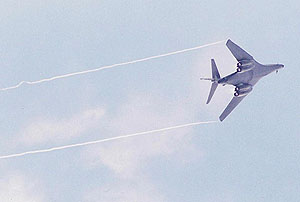 Closing
with impressive reports on trade deals of nearly US$3.2 billion met, such
spending indicates that recovery for the industry is not far away. The
show's organisers, who revealed that over 70 percent of the exhibiting
companies at AA 2002 have confirmed their bookings for the next Asian
Aerospace in 2004, further strengthens this optimistic outlook.
Closing
with impressive reports on trade deals of nearly US$3.2 billion met, such
spending indicates that recovery for the industry is not far away. The
show's organisers, who revealed that over 70 percent of the exhibiting
companies at AA 2002 have confirmed their bookings for the next Asian
Aerospace in 2004, further strengthens this optimistic outlook.
Watch out for Asian Aerospace 2004 - if this year is what the international aviation industry is like in the doldrums, then I'm looking forward to seeing it restored to its former glory or better in two year's time.